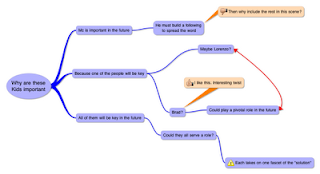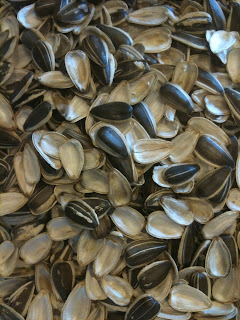It seems that everything needs to be a trilogy. Why not my tools for brainstorming? The wait is over. The final installment is here...
Method III - The Mind Map
Let's start with
Wikipedia:
"A mind map is a diagram used to represent words, ideas, tasks, or other items linked to and arranged around a central key word or idea. Mind maps are used to generate, visualize, structure, and classify ideas, and as an aid to studying and organizing information, solving problems, making decisions, and writing."
Well, if Wikipedia says so, then it must be true. And it is. I've used mind maps for years and I have to say that it has become my tool of choice for generating ideas, brainstorming, thinking out processes, and improving comprehension & recollection.
Let's talk about ideas. I start with the premise that you already have great ideas. Don't argue with me. I believe in you. We are stuck and struggling for ideas not because we don't have the capacity to generate ideas. The ideas are trapped in your head. Trapped. All your day's challenges and work have a dampening effect on your creativity. You are too busy thinking about work, or that term paper, or paying that bill, remembering to call mom, you name it. I say that "We" are creative creatures by design.
Furthermore, I argue that we are less than six degrees of separation from problem to solution. My experience is closer to three. Said differently, the path from your starting point (the challenge/question) to the brilliant idea/breakthrough can be solved in less than six hops.
So what we need is a mechanism to help us extract these ideas. Let me stress this. You need to believe that your mind is infinitely more powerful than you give it credit. I never enter any situation believing that a solution may not be in reach. So please, please, please, do not be a defeatist. Believe in yourself and amazing things will happen
"Things are only impossible until they are not" ~Patrick Stewart as Cpt. Jean-Luc Picard in Start Trek the Next Generation
How do I do this mind map thingy?
The mind map starts with the central node -- the central idea. Think of it as the central question, or problem you're trying to solve. For example, let's say you are Ara eighteen months ago and really wanted to write. You are committed to this path. You stand on your desk and yell, "No more excuses!" Except that you have an excuse -- and it's a nasty one -- time. I have a demanding job. I travel. I have a wife and two boys and two cats, and, and, and.
So you start at the center node: I need more time to write
Now draw a branch from there and brainstorm options. Don't judge them -- not yet. There are no judgements when you brain storm. Get yourself out of the way. Be objective and belive that a solution is somewhere out there. Maybe early in the morning? write it down. Then draw another branch form the central node. How about during work? write it. Next, what about at nights? What if I quit my job? These are all options.
As you write these branches, you may find that your mind immediately generates an association and wants to develop that option. Let your mind roam here. Don't stop inspiration.
In my case when I wrote "At Nights" I drew a node and wrote "When?" Which then led to three new nodes: a) When I get home from work, b) after dinner, c)After the kids are asleep
I can not stress the power of writing it down. Succinct, crisp phrases. Many will add drawings as they do this. Do whatever feels write. But commit it to paper.
The brain opens up secret doors when you commit things to paper. But I don't have to tell you this, do I? Have you noticed how a story unfolds when you actually write it?
Ara, are there tools for this?
There are a lot of great tools out there. And I've used them all. Here are some:
 |
| Click to enlarge image |
Pen & Paper
Nothing more powerful than being able to get a piece of paper and solve a major problem while waiting for a venti iced caramel machiato with an extra shot and some cinnamon powder.
Here I've shown a simple example. The issue is the same as above "How do I make time to write?" In fact this is a recreation of the real mind map I created nearly 18 months ago. In the real one I have some things that are "Personal" so I recreated it here for you.
You can see that I am thinking up of anything and everything.
iThoughtsHD for the Apple iPad
Say what you will about the iPad. It is a mobile tool that has phenomenal apps for almost anything.

Here's a screen print of this fantastic tool.
When I bought it, it was $5. Now it's $10. And worth every penny. In fact. Pay them extra.
Here I show you a bogus scene in a story. The point here is that I am able to quickly create a mind map, then add comments and images to my thoughts: Thumbs up, thumbs down, etc. I can even create links to show potential associations.
Novamind
There are other tools like Novamind, which I also use. It's a great application. You can do amazing things with it. Very intuitive but also a few hundred dollars depending on which version you get. In fact, with the iPad and iThoughts HD, I don't see a need for any other tool.
Below is a screen print of a complex mind map I created for fleshing out ideas. One of my reference books is "James Scott Bell's Plot & Structure. JSB explains the LOCK framework (Lead - Objective - Challenge - Knockout Ending). I created a template in Novamind so that I think of these items as I develop the concept.
A final word on the concept of "solution." Sometimes the solution is a painful one. It does not change the fact that it is a solution. In my case, in order to write I had to give up the concept of seven hours of sleep. So when I say that I believe we can find a solution to anything, there is a caveat that says, if it matters to you, you will be more excited over doing what you love and not be too concerned over what you have to give up.
BONUS MATERIAL:
And for sticking with me, I share this video by Stephen Pierce. This video shows you a very simple method in using Mind Mapping to accelerate comprehension when reading. I guarantee that with minimal effort you will be able to retain information better than ever before.
The key is that when you read something or you attend a conference, you need to have a goal, or a purpose for what you hope to learn. Get that etched in, then start mind mapping while listening. I guarantee better comprehension and recollection.
I use mind mapping when I read an article of interest. When I go to conferences and I want to get the core message with all the rest set aside.
I shared my mind map for JSB's LOCK framework. You guessed it. I created that when I first read the book. I wanted to make sure I understood and internalized it.
Fight the good fight.
 While on the elevator, headed to the 23rd floor, I met Dominika Cubilkova.
While on the elevator, headed to the 23rd floor, I met Dominika Cubilkova. While I ate breakfast I saw a young guy staring at her like a love-starved pup. I wondered what he did? Was he a tennis player also? Maybe he was a young executive... or maybe he was there with his mom and dad :)
While I ate breakfast I saw a young guy staring at her like a love-starved pup. I wondered what he did? Was he a tennis player also? Maybe he was a young executive... or maybe he was there with his mom and dad :) As I ate breakfast my writer's mind started to work quickly... by the way, the prosciutto ham, sharp cheese, fresh baguettes and everything else is to die for! As are the single serving Nutella packs... (excuse me while I clean my salivating mouth)
As I ate breakfast my writer's mind started to work quickly... by the way, the prosciutto ham, sharp cheese, fresh baguettes and everything else is to die for! As are the single serving Nutella packs... (excuse me while I clean my salivating mouth) The waitress that carried them had this determined look on her face. Dominika's huge tennis racket bag lay on the floor, but the waitress maneuvered around it with grace. So I thought, what if she hadn't?
The waitress that carried them had this determined look on her face. Dominika's huge tennis racket bag lay on the floor, but the waitress maneuvered around it with grace. So I thought, what if she hadn't?
 I went to the office and all day this idea brewed. Thoughts of an opening scene populated my jet-lagged head. That night, when I returned to the hotel, I went to the bar. It has a very creative name... "Le Bar"
I went to the office and all day this idea brewed. Thoughts of an opening scene populated my jet-lagged head. That night, when I returned to the hotel, I went to the bar. It has a very creative name... "Le Bar"










